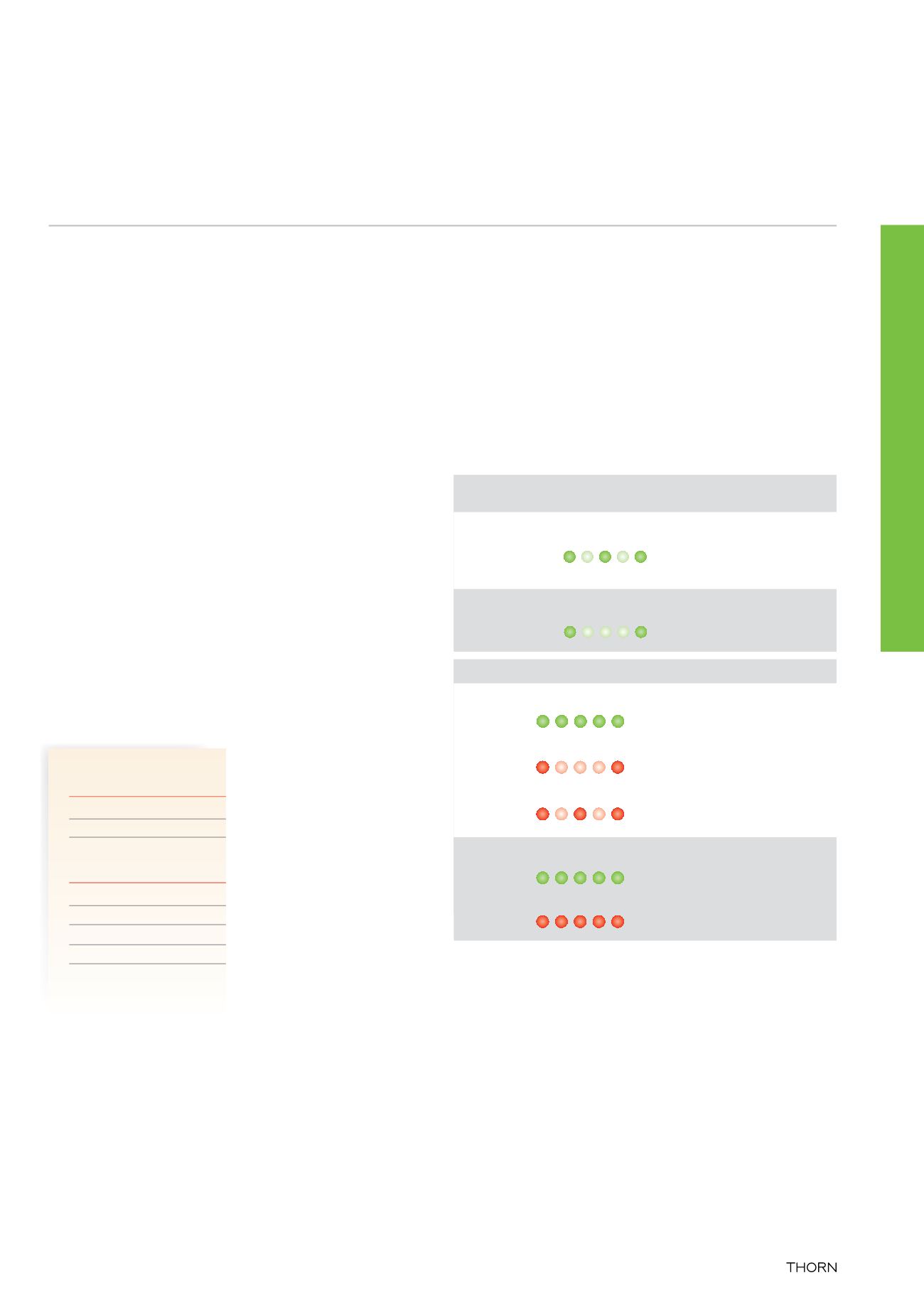

539
Automatic Self Testing
Each self test emergency luminaire
contains an intelligent diagnostic
processor that automatically performs
the testing and uses the integrated
bi-colour LED indicator to show the
test results.
SelfTest fittings provide simple and
reliable standalone automatic testing
solutions. The building operative only
needs to walk around the building
once a month and check the status of
the LED indicators. The overall result
must be recorded in a central log
book, with details of any failures.
9 February 2008
All LEDs showing green.
System clear of all faults.
10 March 2008
One LED showing steady
red. Luminaire opposite the
lift on second floor requires
lamp replacement. All
other LEDs showing green.
Component
LED Indicator
Status
Action
Battery
Green Steady
Healthy
OK
Red Slow Flash
Low
Wait 24hrs and recheck
Red Rapid
Not charging
Service required
Lamp
Green Steady
Healthy
OK
Red Steady
Failure
Service required
Test
LED Indicator
Duration Frequency
EN
requirement
Function Test
(Energise luminaire
from battery briefly to
simulate mains failure)
Green Rapid Flash
30 seconds Weekly
Monthly
Duration Test
(Energise luminaire for
full rated duration)
Green Slow Flash
1 or 3 hours Annually
Annually
SelfTest fittings offer a variety
of benefits:
•Easy to install, with no additional
cabling and automatic
self-commissioning
•The building owner only needs to
walk round the building once per
month and record the result
•Faster than average recharge time
for emergency batteries (around
10 - 15 hours, compared to 24
hours for Manual Test fittings)
•3 hours operation, to facilitate
re-entry following an evacuation
•Bi-colour LED (red and green) to
provide clear status indication
•Boost starting technology gives
higher lumen output during most
critical phase to ensure greater
visibility of potential danger
•Cathode heating during
emergency operation prolongs
emergency lamp life
•Intelligent processor learns to test
while the building is unoccupied,
reducing potential risk
Applications
SelfTest is an ideal testing solution
for small applications or building
refurbishments.
Key examples include small shops,
offices and public buildings.
Basic Manual Testing
This kind of emergency luminaire relies on intensive human intervention to
comply with the stringent testing regulations.
Every month a competent individual must walk around the site and manually switch
the fittings into the emergency test mode. This will perform a functional test, after
which an individual record sheet must be completed and safely stored. The same
process must be carried out for the 3 hour duration test once every year.
In this case, the LED indicator only shows whether the battery is being charged.
Any further fault requires manual examination of the fitting. Combined with the
fact that a competent individual has to walk around the site every month, basic
manual testing luminaires incur high whole life costs due to expensive labour
charges for testing and maintenance.
Applications
Basic manual test is suitable for budget-driven installations where the whole
life costs are not considered
Sensa 3 TSC
For larger applications with more than 240 emergency fittings, Sensa 3 TSC
allows the building operator to monitor and manage the emergency lighting
scheme from a standard computer. Sensa 3 TSC enables a standard computer
to communicate with local controllers using the installed computer network.
Applications
Sensa 3 TSC has the ability to control an infinite number of emergency
luminaires. In applications such as university accommodation blocks, hotels,
large offices, hospitals and air ports, Sensa 3 TSC will deliver significant time
and cost savings in terms of maintenance and inspection.
Controls and Emergency Lighting Emergency Lighting www.thornlighting.co.uk

















